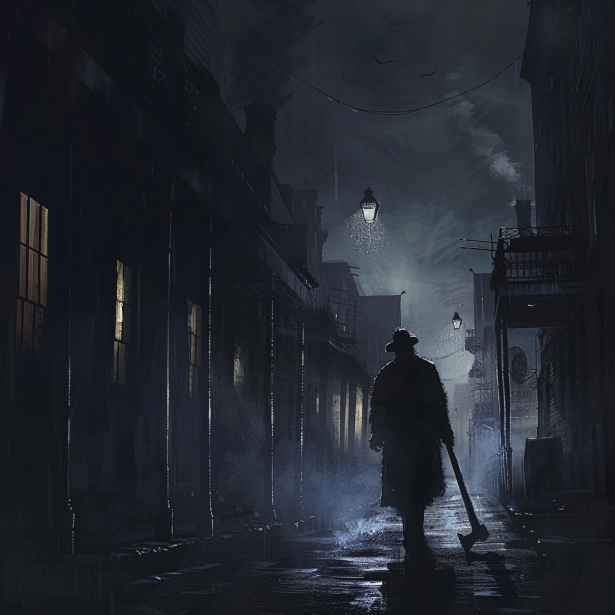Introduction
From 1918 to 1919, New Orleans was gripped with fear as a serial killer known as the Axeman terrorized the city. The Axeman targeted Italian-American grocers and their families, attacking them with an axe or straight razor, often using the victims’ own tools found on the premises. His gruesome spree left six people dead and several others injured.
The Axeman sent a notorious letter to the local newspaper in March 1919, claiming he would spare anyone playing jazz music on a specific night, leading to a citywide jazz-playing frenzy. Despite extensive investigations and multiple suspects, the identity of the Axeman remains a mystery to this day, making him one of America’s most enigmatic and chilling serial killers.
The Axeman’s Crime Spree
Timeline of Attacks
- First Known Attack (May 23, 1918): Joseph Maggio, a grocer, and his wife, Catherine, were brutally attacked in their home. Joseph survived for a short period, but Catherine died at the scene.
- Subsequent Attacks: Over the next year, the Axeman continued his reign of terror, attacking several more victims, including Louis Besumer and his mistress Harriet Lowe (June 27, 1918), Anna Schneider (August 5, 1918), and Joseph Romano (August 10, 1918), among others.
- Final Attack (October 27, 1919): Mike Pepitone was attacked and killed, marking the last known crime attributed to the Axeman.
Modus Operandi
The Axeman typically targeted Italian-American grocers and their families. He would often break into their homes during the night, using tools such as axes or straight razors found on the premises. The victims were usually attacked in their sleep, leading to gruesome and fatal injuries.
The Infamous Letter
Publication in the Newspaper
In March 1919, the Axeman sent a letter to the local newspaper, “The Times-Picayune,” that sent shockwaves through the city. The letter, dated March 13, 1919, claimed that the Axeman would strike again at 15 minutes past midnight on the night of March 19, but would spare anyone playing jazz music.
Content of the Letter
The letter read:
“Esteemed Mortal of New Orleans: They have never caught me and they never will. They have never seen me, for I am invisible, even as the ether that surrounds your earth. I am not a human being, but a spirit and a demon from the hottest hell. I am what you Orleanians and your foolish police call the Axeman…”
Jazz Frenzy
Fearing for their lives, the residents of New Orleans played jazz music in their homes and clubs throughout the night of March 19. The city was filled with the sounds of jazz, and true to his word, no attacks were reported that night.
Investigation and Suspects
Police Efforts
The New Orleans police conducted extensive investigations, but the Axeman’s identity remained elusive. Several suspects were arrested, but none were definitively linked to the crimes.
Notable Suspects
- Joseph Mumfre: One of the most prominent suspects was Joseph Mumfre, a criminal with a history of violence. In 1920, he was shot and killed by Mike Pepitone’s widow, who claimed he was the Axeman. However, no concrete evidence linked him to the murders.
- Other Theories: Various other theories have been proposed, including connections to the Mafia, personal vendettas, or the possibility that the Axeman was a deranged individual acting alone.
Legacy and Cultural Impact
Jazz and the Axeman
The Axeman’s letter and the subsequent jazz-playing frenzy have become a significant part of New Orleans’ cultural lore. The event is often referenced in jazz history and has inspired numerous artistic works.
Media and Literature
The Axeman’s story has been depicted in various books, documentaries, and TV shows, including a notable portrayal in the series “American Horror Story: Coven,” where the Axeman is presented as a central character.
Conclusion
The Axeman of New Orleans remains one of America’s most enigmatic and chilling serial killers. Despite the passage of over a century, his identity and motives continue to elude investigators and historians. The Axeman’s reign of terror and the infamous letter that plunged New Orleans into a night of jazz remain etched in the city’s history, contributing to the legend of a killer who has never been brought to justice.
FAQs
Who was the Axeman of New Orleans?
The Axeman of New Orleans was an unidentified serial killer who terrorized the city from 1918 to 1919, targeting Italian-American grocers and their families with axes and straight razors.
What was the Axeman’s modus operandi?
The Axeman typically broke into homes at night, using tools found on the premises to attack his victims, often while they slept. His targets were predominantly Italian-American grocers.
What was the significance of the Axeman’s letter?
In March 1919, the Axeman sent a letter to a local newspaper claiming he would spare anyone playing jazz music on a specific night. This led to a citywide jazz-playing frenzy, and no attacks occurred that night.
Were any suspects identified or arrested?
Several suspects were arrested, but none were definitively linked to the Axeman’s crimes. Joseph Mumfre was a notable suspect, but concrete evidence was lacking.
What impact did the Axeman have on New Orleans?
The Axeman’s crimes and the ensuing letter significantly impacted New Orleans, embedding the story into the city’s cultural lore and inspiring various artistic works.
Is the identity of the Axeman known?
No, the Axeman’s identity remains unknown, and the case is officially unsolved despite extensive investigations and numerous theories.

